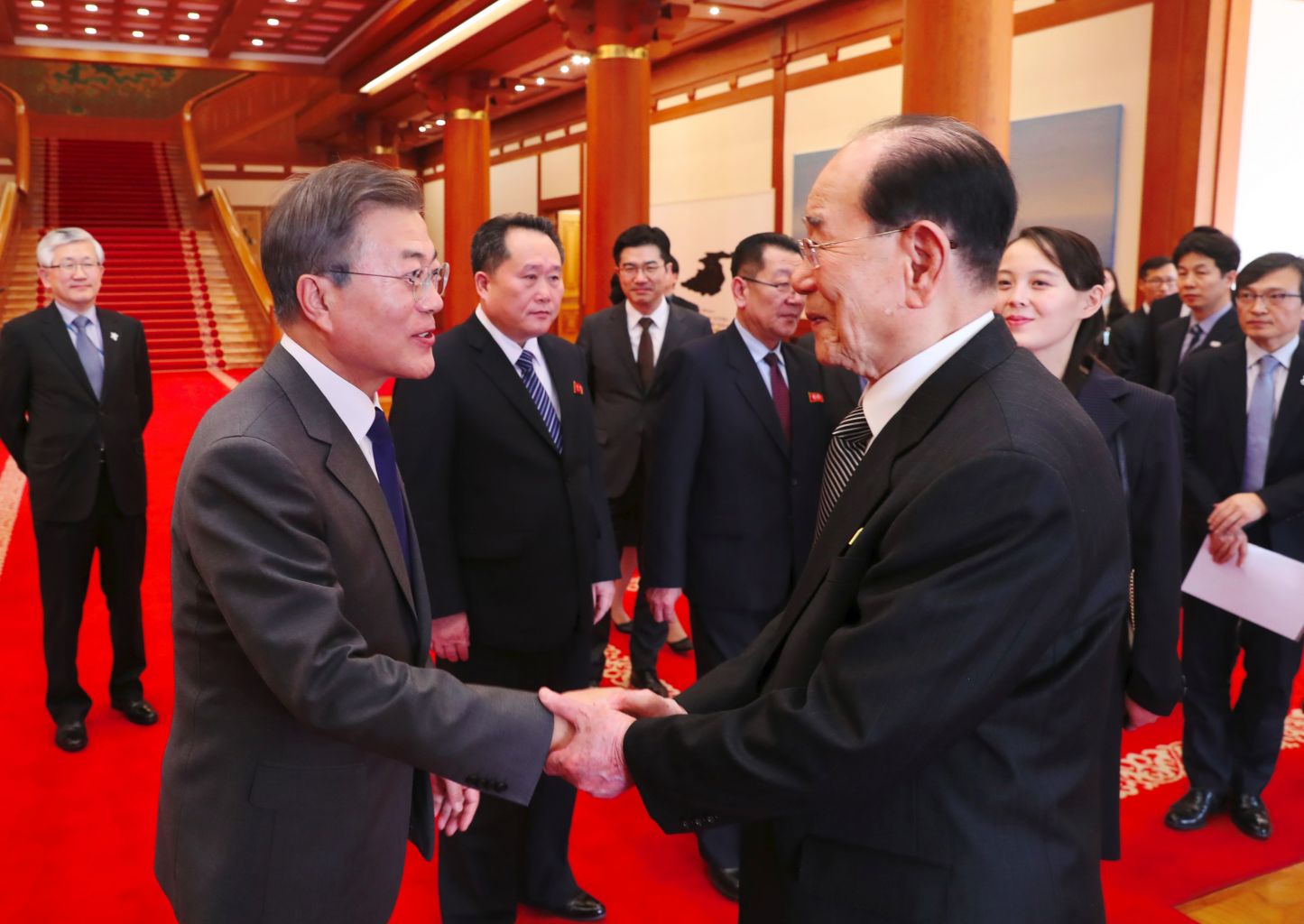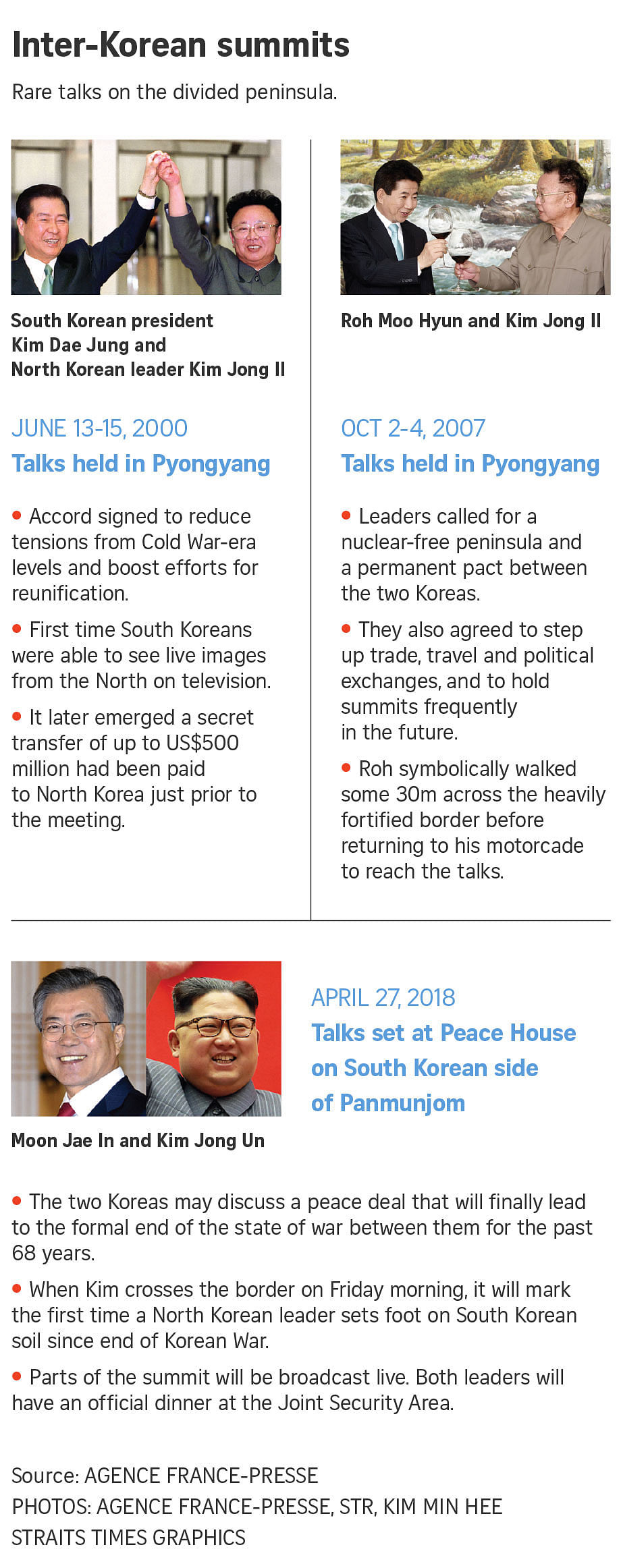Champagne and songs: What happened at previous inter-Korean summits
Sign up now: Get ST's newsletters delivered to your inbox

South Korea's President Moon Jae In (left) greets North Korea's ceremonial head of state Kim Yong Nam before their meeting at the Blue House in Seoul, on Feb 10, 2018.
PHOTO: AFP
Follow topic:
SEOUL (AFP, REUTERS) - North and South Korea will on Friday (April 27) hold only their third summit since the end of the Korean War, with Pyongyang's nuclear arsenal and a peace treaty to formally end the conflict on the agenda.
The meeting comes ahead of an expected but unprecedented encounter between Kim Jong Un and US President Donald Trump. Here is a summary of what happened at the two earlier summits, both of them in Pyongyang:
FIRST SUMMIT, PYONGYANG (June 13-15, 2000)
The first inter-Korean summit nudged the two Koreas away from Cold War confrontation towards reconciliation and exchange.
South Korea's then president Kim Dae Jung, who won a Nobel Peace Prize for his Sunshine policy of engagement with the North, visited Pyongyang for an unprecedented inter-Korean summit with late leader Kim Jong Il.
Kim Jong Il surprised the world with a rare foray into the international spotlight by going to the airport to personally greet the South's president Kim Dae-jung, in emotional scenes broadcast live in the South.
Hundreds of thousands of people, women wearing colourful traditional robes known as hanbok in the South and joseon-ot in the North, men in suits and ties, all waving red and pink paper flowers, lined the streets to give Kim Dae Jung a carefully stage-managed hero's welcome.
"I am happy to see you, I have wanted to for a long time," the visitor told his host.
"We are the same Chosun (Korean) people," said Kim Jong Il.
On a shared limousine ride, Kim Dae Jung later wrote in his memoirs, Kim Jong Il asked him: "Are you scared to come to the North?"
During the three-day visit, the pair signed an accord on reducing tensions and boosting efforts for reunification, including moving towards a permanent peace on the Korean peninsula - which has remained technically at war since the 1953 ceasefire - and bringing together divided families.
At a farewell lunch, the two leaders joined hands to sing "Our Wish Is Unification".
The meeting led to a series of reunions of families separated by the 1950-53 Korean War, as well as the launch of a joint factory park in the North's border town of Kaesong in 2004.
Kim Jong Il travelled to Beijing to meet then Chinese president Jiang Zemin before the summit. The North and the United States were also holding a series of high-level talks on Pyongyang's nuclear and missile programmes.
The meeting was applauded by world leaders, with the United States hailing a "new day of hope".
But while the summit helped earn Kim Dae Jung a Nobel Peace Prize, it later emerged up to US$500 million had been paid secretly to North Korea just before the meeting via the Hyundai business group, with critics denouncing what they called a "cash-for-summit" scandal.
Hyundai had various projects in the North including tours to the scenic Mount Kumgang, but they came to a halt in 2008 when a South Korean tourist was shot dead after stumbling into an off-limits military zone.
The Seoul-invested Kaesong industrial park was shut down in 2016 after the North's fourth nuclear test.

SECOND SUMMIT, PYONGYANG (Oct 2-4, 2007)
The second summit came amid an upbeat mood in six-nation negotiations over North Korea's nuclear disarmament, despite its first nuclear test a year earlier.
The meeting came amid brisk diplomacy among the members of six-party denuclearisation talks - the United States, China, Japan, Russia and the two Koreas.
The six nations were working to implement a framework deal they reached in September 2005 under which Pyongyang was to give up its nuclear programme in return for massive economic and energy aid and an end to its diplomatic isolation.
In a highly symbolic gesture, South Korean President Roh Moo Hyun - a liberal South Korean president who carried on with Kim Dae Jung's engagement policy - walked some 30 metres across the heavily fortified border before returning to his motorcade to carry on to Pyongyang.
The frontier "has divided the nation for half a century. It has caused enormous pain to our nation and hampered development," he said in comments televised worldwide.
Roh said later that he was unable to sleep on his first night in Pyongyang as he felt "formidable differences in thought" with the North. "I was not sure whether we could agree on a single point," he added.
But the two leaders signed a declaration, built on the 2000 declaration, calling for a nuclear-free peninsula and a permanent peace pact between the two Koreas.
"The South and North will not take a hostile stance towards each other and will reduce military tension and resolve issues of conflict through dialogue and negotiation," the declaration said.
They agreed to step up trade, travel and political exchanges, and to hold summits frequently in future.
At the end of the meeting, Kim shook hands and clinked champagne glasses with Roh, who was visibly upbeat and planted a tree before he left Pyongyang.
International reaction was more lukewarm than after the first summit, with the United States saying that Korean peace hinged on the North's agreement to dismantle its nuclear weapons programme.
The South's Sunshine Policy of engaging with the North came to an end when the conservative Lee Myung Bak came to power the following year, and in 2009 the North walked out of the Six-Party Talks before carrying out its second nuclear test.
Kim died in 2011 and was succeeded by his son Kim Jong Un, who oversaw a rapid acceleration in the progress of its nuclear and missile technology - accompanied by increasingly strong sanctions by the UN Security Council and others - with tensions mounting until the rapprochement triggered by this year's Winter Olympics in the South.

